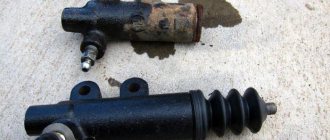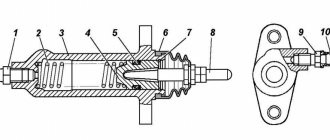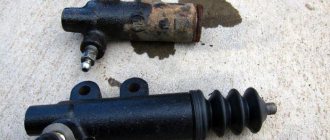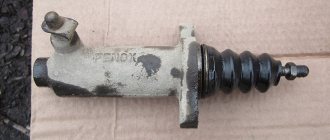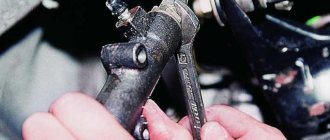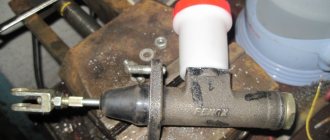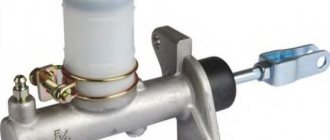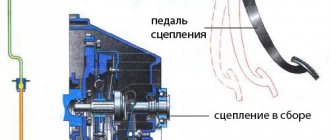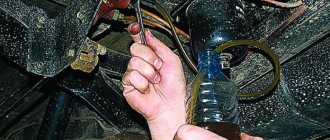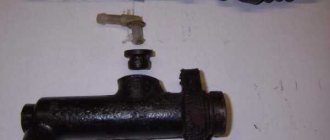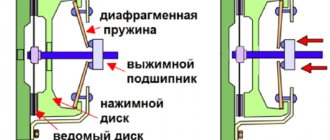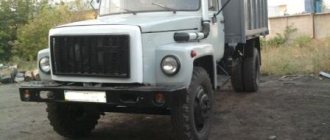Design
Unlike front-wheel drive foreign cars, on all-wheel drive UAZ Patriot vehicles the clutch slave cylinder (its adjustment is at the end of the article) is hydraulic and is controlled using fluid pressure, and not a cable. The design of this element includes several components. This:
- Frame. It is made of plastic or metal.
- Piston (working rod).
- A valve that releases air when the clutch system is bleeding (adjusting).
- Retaining ring.
- O-rings. Made from durable rubber.
- Return spring.
- Pusher. It affects the previous element.
Clutch epic. Drama in pictures.
I haven’t liked the clutch on my UAZ for a long time. The reservoir was leaking at the top, the cylinder was leaking at the bottom, and it was also filled with BSK, unlike the brakes, which I had long since converted to the modern DOT standard. In addition, it only worked close to the floor, and the idle speed of the pedal was enormous. In general, it’s a complete disgrace, not a grip.
And finally, hands came to him. So what do we have? Main flow:
What is the reason? Here's what:
The tank burst. In fact, they often burst for no apparent reason - that’s the quality. In theory, you can look for the reservoir separately and replace it, or even solder the existing one (although this, as practice shows, does not help much), however, I am going to change the type of brake fluid from BSK to DOT, and they are incompatible. This can also be circumvented by disassembling the cylinder, replacing the cuffs and thoroughly washing it with alcohol or DOT brake fluid, but... Really, this is an excessive hassle, and now go find that repair kit. Therefore, I am changing the main assembly. It costs 520 rubles in our area.
We substitute a cut bottle for brake fluid - how did our wild ancestors live before the invention of the plastic bottle?
And, having unscrewed the tube (key 12), two nuts from under the panel (end nut 13) and disconnecting the fork from the pedal (two keys 13), remove the main one. We replace it with a new one in the reverse order, but...
Do you see what happened to the pedal?
The hole into which the master cylinder rod fork is inserted is completely broken - hence the indecent idling of the pedal. And a spring wound with wire is what is called a “collective farm”. Not on my car!
We make a sleeve. To do this, take a harder iron nut and... a file!
Yes, yes - a simple ordinary file, a vice - and, as in labor lessons at school... The older generation will understand me. We cut off the edges and cut off the threads.
Then we finalize the pedal with a file:
We expand the hole for the bushing, moving it as far as possible to the edge in order to reduce the required length of the rod.
Here, the bushing is in place:
All that remains is to secure it there, and for this there is nothing better than welding. Kemp, of course, is more convenient, but I have it in the recovery stage, after being in the wrong hands (never give your instrument to anyone!), so with a triple electrode, carefully:
Then we grind the resulting structure, removing the welding seams:
And here is the result:
All that remains is to install the spring properly - for this it is enough to remove the wire and not be too lazy to wrap the first turn with a crochet hook. Of course, everything is lubricated with graphite and, after selecting the thickness of the washer so that the fork has no side play, it is mounted on the machine. Normal free play is 35–55 mm. The full stroke, by the way, should be 185 mm for a spring-lever clutch, and that is also worth checking.
Now that we've sorted out the pedal and replaced the main one, it's time to make a working one. To begin with, we remove the old working cylinder - due to a torn boot, who knows when, the cylinder mirror is covered with sand and there is no talk of repair at all. To begin with, we thoroughly rinse the tube and hose from the remnants of the BSK - running the pedal through it from the main brake pump under pressure. I spilled half a liter, that should be enough. However, if you have an extra hose, replace it, it won’t hurt. It's more reliable that way. And then we change the worker...
And here I made a shameful mistake, showing excessive gullibility. Instead of a UAZ worker, the cunning salesman rubbed me a Gazelle. No, it's not that I got them mixed up - but he convinced me that they were interchangeable. Indeed, very similar:
And according to the fasteners, it fits in the same place, and the hose fits, and the rod, but... it doesn’t work as it should. The fact is that the old UAZ has a spring-lever clutch, with a normally released release. On Hunters and Gazelles - aperture-blade, with a normally pressed release lever. That is, the clutch fork on the 469 should have a free play of about 17 millimeters at the lower end. The spring on the fork pushes it away from the basket, and the release bearing hangs in the air and does not spin. On a diaphragm type there is no free play, and the bearing rotates along with the basket. This is the difference. If you install a Gazelle worker, then the fork will not have free play - it has a spring-loaded piston. That is why it has a non-adjustable rod, unlike the UAZ one, where it is threaded with a lock nut. And to me, naive, the seller sang about “automatic adjustment”, saying that a threaded rod would not be needed. He is partly right - but not for 469. But I’m so smart now that I figured out the issue, but in the store I didn’t know this yet. In general, do not trust sellers, always figure it out yourself FIRST. 235 rubles in the red for nothing - you can, of course, find that seller and shove it flat in his ass and return this cylinder to him, but it’s not worth the lost time and nerves. I've already lost enough of them by putting in the wrong cylinder and trying to get it to work.
In general, I bought a new one, my own:
By the way, it’s noticeably more expensive – 360 rubles.
Here they are, together:
First unscrew the cylinder from the clutch housing, and then the hose from it - it’s much more convenient, but otherwise you won’t be able to unscrew it, by the way, the tube won’t work. The bleeder fitting (at 11) is located in such a way that you can’t get to it with a wrench, but I didn’t even bleed it - it was enough to bleed the cylinder hanging down on the hose with the unscrewed fitting by gravity.
By the way, you are unlikely to be able to confuse a UAZ original part with something else - look at the factory (!) boot mount:
On what other car is it tied with wire at the factory? This is a UAZ, baby!
Yes, it was a hot day:
But the clutch now works softly, clearly and accurately, which is what I wish for you.
Don't repeat my mistakes!
Signs of trouble
How do you know if your car needs to replace the clutch slave cylinder? UAZ is a very reliable car, but this part can also fail. A breakdown can be determined by several signs. Firstly, this is a sharp decrease in the liquid level in the tank. If there is a leak, the cylinder boot may have broken through. Damage may also affect rubber or aluminum tubes. Check their integrity. Secondly, the pedal stroke becomes softer. “Clutch failures” are observed. This indicates the presence of air in the system.
Adjusting the UAZ Patriot clutch sensor (error 0704)
I got tired of error 07074 on the BC, over the weekend I missed misfires because of it, on a healthy engine this indicates bad fuel. In this case, it is confirmed that the Honda from the column
